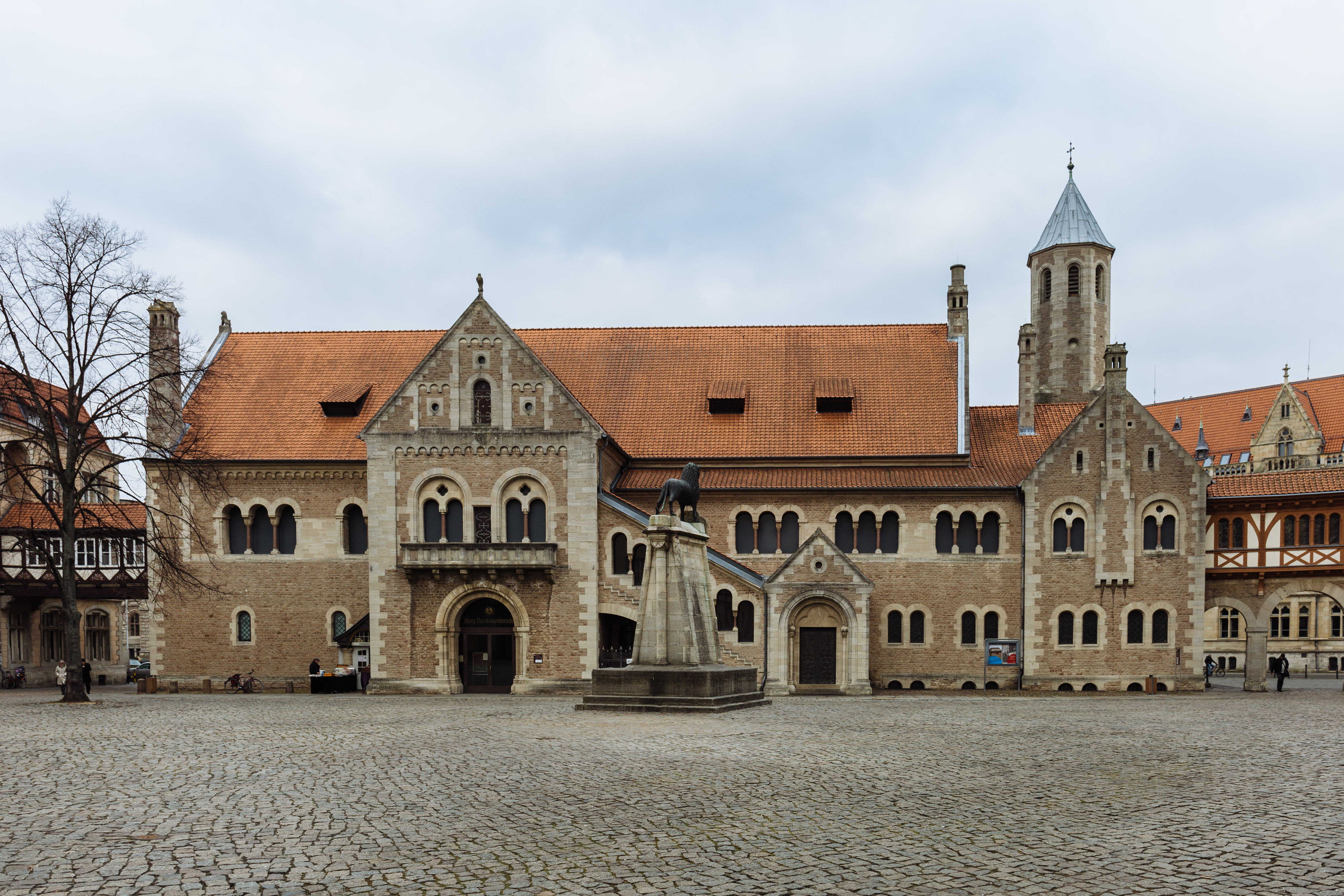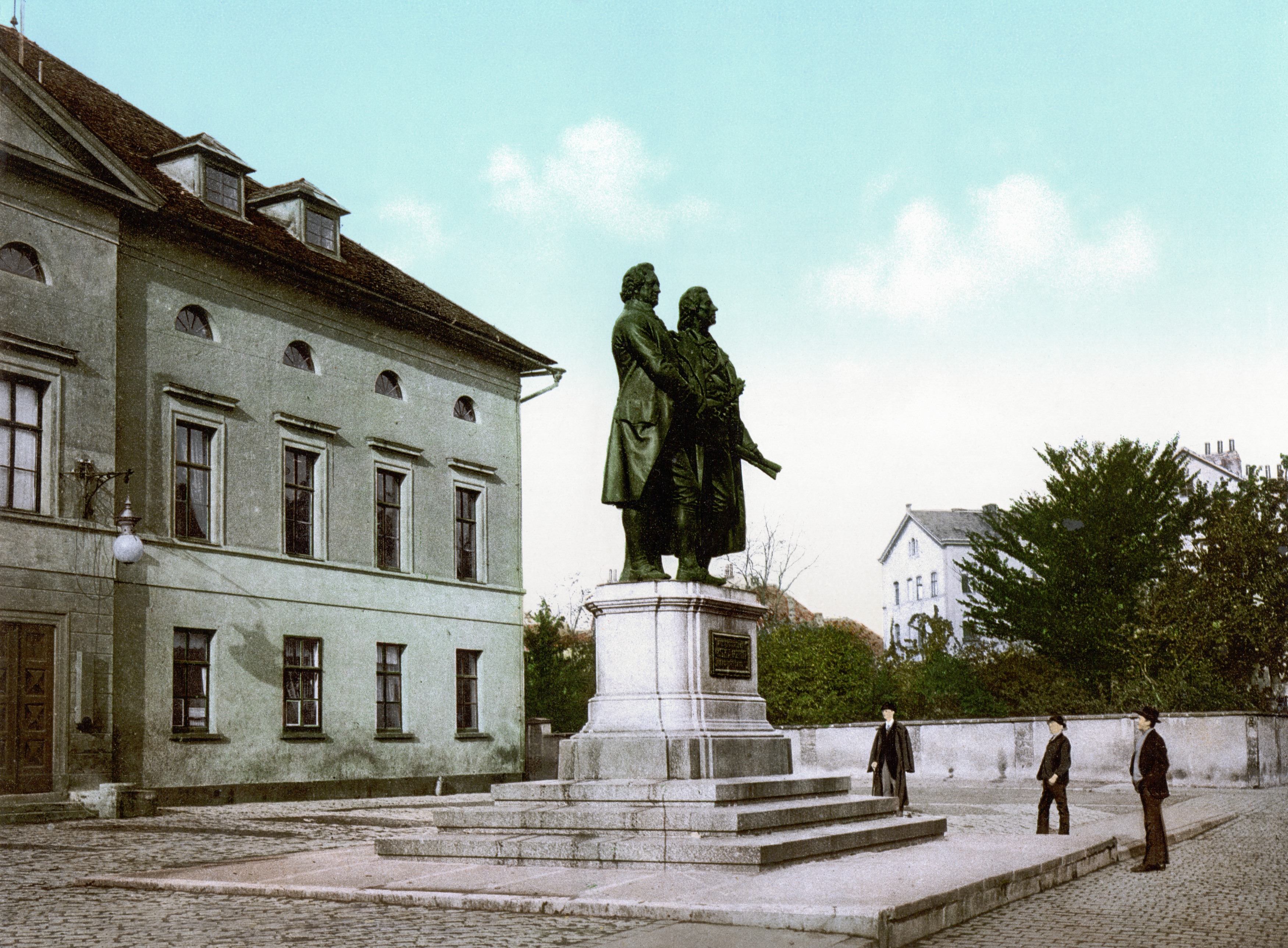|
Ernst Rietschel
Ernst Friedrich August Rietschel (15 December 180421 January 1861) was a German sculptor. Life Rietschel was born in Pulsnitz in Saxony the third child of Friedrich Ehrgott Rietschel and his wife Caroline. From the age of 20 he became an art student at Dresden, and from 1826 was a pupil of Rauch in Berlin. He there gained an art studentship, and studied in Rome in 1827–28. After returning to Saxony, he soon brought himself into notice by a colossal statue of Frederick Augustus, King of Saxony; was elected a member of the academy of Dresden, and became one of the chief sculptors of his country. In 1832 he was elected to the Dresden professorship of sculpture, and had many foreign orders of merit conferred on him by the governments of different countries. He died in Dresden in 1861 aged 56. He is buried in the Trinitatisfriedhof, north-east of the city centre. Family He married three times. Firstly in 1832 to Albertine Trautscholdt. In 1836 he married Charlotte Carus daug ... [...More Info...] [...Related Items...] OR: [Wikipedia] [Google] [Baidu] |
Pulsnitz
Pulsnitz (German, ; Upper Sorbian name: ''Połčnica'', ) is a town in the district of Bautzen, in the Free State of Saxony, in eastern Germany. It is situated on the small river Pulsnitz, 11 km southwest of Kamenz, and 24 km northeast of the centre of Dresden. History Initially a Sorbian stronghold and settlement, it was first mentioned in 1225. It was granted town rights in 1375. It was raided by the Hussites in 1429. Pulsnitz became famous for its Pfefferkuchen, a type of Christmas cookie, when in 1558 the bakers of Pulsnitz received permission to bake them. Today there are still eight ''Pfefferküchlereien'' bakeries. In 1745 the ''Pfefferküchler'' Tobias Thomas was known to be practising his craft in Pulsnitz as well as in Toruń, Poland, where the famous Toruń gingerbread were made. Pulsnitz is informally known as ''Pfefferkuchenstadt'' meaning "Gingerbread Town". Other crafts also developed, with a linen weavers' guild founded in 1597, and the first local ... [...More Info...] [...Related Items...] OR: [Wikipedia] [Google] [Baidu] |
Braunschweig
Braunschweig () or Brunswick ( ; from Low German , local dialect: ) is a List of cities and towns in Germany, city in Lower Saxony, Germany, north of the Harz Mountains at the farthest navigable point of the river Oker, which connects it to the North Sea via the rivers Aller (Germany), Aller and Weser. In 2024, it had a population of 272,417. The Braunschweig-Wolfsburg-Salzgitter region had 1.02 million residents including the cities Wolfsburg and Salzgitter, it is the second largest urban center in Lower Saxony after Hanover. The urban agglomeration of Braunschweig had a population of 551,000 with almost 45% having a migration background, making it the most diverse urban agglomeration in the whole Niedersachsen, state. The city consists of 37.5% immigrants (approximately 102,000) with a high amount of migrants coming from other European countries, Asia and Africa. 73% of the Germans residing in Braunschweig come from different parts of the country, particularly North Rhine West ... [...More Info...] [...Related Items...] OR: [Wikipedia] [Google] [Baidu] |
German Male Sculptors
German(s) may refer to: * Germany, the country of the Germans and German things **Germania (Roman era) * Germans, citizens of Germany, people of German ancestry, or native speakers of the German language ** For citizenship in Germany, see also German nationality law **Germanic peoples (Roman era) * German diaspora * German language * German cuisine, traditional foods of Germany People * German (given name) * German (surname) * Germán, a Spanish name Places * German (parish), Isle of Man * German, Albania, or Gërmej * German, Bulgaria * German, Iran * German, North Macedonia * German, New York, U.S. * Agios Germanos, Greece Other uses * German (mythology), a South Slavic mythological being * Germans (band), a Canadian rock band * "German" (song), a 2019 song by No Money Enterprise * ''The German'', a 2008 short film * "The Germans", an episode of ''Fawlty Towers'' * ''The German'', a nickname for Congolese rebel André Kisase Ngandu See also * Germanic (disambig ... [...More Info...] [...Related Items...] OR: [Wikipedia] [Google] [Baidu] |
People From The Electorate Of Saxony
The term "the people" refers to the public or common mass of people of a polity. As such it is a concept of human rights law, international law as well as constitutional law, particularly used for claims of popular sovereignty. In contrast, a people is any plurality of persons considered as a whole. Used in politics and law, the term "a people" refers to the collective or community of an ethnic group or nation. Concepts Legal Chapter One, Article One of the Charter of the United Nations states that "peoples" have the right to self-determination. Though the mere status as peoples and the right to self-determination, as for example in the case of Indigenous peoples (''peoples'', as in all groups of indigenous people, not merely all indigenous persons as in ''indigenous people''), does not automatically provide for independent sovereignty and therefore secession. Indeed, judge Ivor Jennings identified the inherent problems in the right of "peoples" to self-determination, as i ... [...More Info...] [...Related Items...] OR: [Wikipedia] [Google] [Baidu] |
1861 Deaths
This year saw significant progress in the Unification of Italy, the outbreak of the American Civil War, and the emancipation reform abolishing serfdom in the Russian Empire. Events January * January 1 ** Benito Juárez captures Mexico City. ** The first steam-powered carousel is recorded, in Bolton, England. * January 2 – Friedrich Wilhelm IV of Prussia dies, and is succeeded by Wilhelm I. American Civil War: ** January 3 – Delaware votes not to secede from the Union. ** January 9 – Mississippi becomes the second state to secede from the Union. ** January 10 – Florida secedes from the Union. ** January 11 – Alabama secedes from the Union. ** January 12 – Major Robert Anderson sends dispatches to Washington. ** January 19 – Georgia secedes from the Union. ** January 21 – Jefferson Davis resigns from the United States Senate. ** January 26 – Louisiana secedes from the Union. * January 29 – Kansas is adm ... [...More Info...] [...Related Items...] OR: [Wikipedia] [Google] [Baidu] |
1804 Births
Events January–March * January 1 – Haiti gains independence from France, and becomes the first black republic. * February 4 – The Sokoto Caliphate is founded in West Africa. * February 14 – The First Serbian uprising begins the Serbian Revolution. By 1817, the Principality of Serbia will have proclaimed self-rule from the Ottoman Empire, the first nation-state in Europe to do so. * February 15 – New Jersey becomes the last of the northern United States to abolish History of slavery in New Jersey, slavery. * February 16 – First Barbary War: Stephen Decatur leads a raid to burn the pirate-held frigate at Tripoli, Libya, Tripoli to deny her further use by the captors. * February 18 – Ohio University is chartered by the Ohio General Assembly. * February 20 – Hobart is established in its permanent location in Van Diemen's Land (modern-day Tasmania) as a British penal colony. * February 21 – Cornwall, Cornishman Richard Trevithick's newly built ''Penydarren' ... [...More Info...] [...Related Items...] OR: [Wikipedia] [Google] [Baidu] |
Goethe–Schiller Monument
The original ''Goethe and Schiller Monument'' (German: ''Goethe-Schiller-Denkmal'') is in Weimar, Germany. It incorporates Ernst Rietschel's 1857 bronze double statue of Johann Wolfgang von Goethe (1749–1832) and Friedrich Schiller (1759–1805), who are probably the two most revered figures in German literature. The monument has been described "as one of the most famous and most beloved monuments in all of Germany" and as the beginning of a "cult of the monument". Dozens of monuments to Goethe and to Schiller were built subsequently in Europe and the United States. Goethe and Schiller had a remarkable friendship and collaboration that was "like no other known to literature or art." Both men had lived in Weimar, and were the seminal figures of a literary movement known as '' Weimar Classicism''. The bronze figures of the Goethe–Schiller statue are substantially larger than life-size; notably, both are given the same height, even though Goethe was nearly 20 cm shorter th ... [...More Info...] [...Related Items...] OR: [Wikipedia] [Google] [Baidu] |
Luther Monument (Washington)
The Luther Monument is a public artwork located in front of Luther Place Memorial Church in Washington, D.C., United States. The monument to Martin Luther, the theologian and Protestant Reformer, is a bronze, full-length portrait. It is a copy of the statue created by Ernst Friedrich August Rietschel as part of the 1868 Luther Monument in Worms, Germany. The version in Washington, D.C., inspired the installation of many other castings across the U.S. The statue is a contributing property to the Luther Place Memorial Church's listing on the National Register of Historic Places (NRHP) and District of Columbia Inventory of Historic Sites (DCIHS). It is also a contributing property to the Greater Fourteenth Street Historic District, which is also listed on the NRHP and DCIHS. The plan to erect a statue began in 1883. A group of interested people formed an association and began a fundraising effort. The total cost of the statue and granite pedestal, designed by Adolf Cluss and P ... [...More Info...] [...Related Items...] OR: [Wikipedia] [Google] [Baidu] |
Bas-relief
Relief is a sculptural method in which the sculpted pieces remain attached to a solid background of the same material. The term ''relief'' is from the Latin verb , to raise (). To create a sculpture in relief is to give the impression that the sculpted material has been raised above the background plane. When a relief is carved into a flat surface of stone (relief sculpture) or wood ( relief carving), the field is actually lowered, leaving the unsculpted areas seeming higher. The approach requires chiselling away of the background, which can be time-intensive. On the other hand, a relief saves forming the rear of a subject, and is less fragile and more securely fixed than a sculpture in the round, especially one of a standing figure where the ankles are a potential weak point, particularly in stone. In other materials such as metal, clay, plaster stucco, ceramics or papier-mâché the form can be simply added to or raised up from the background. Monumental bronze reliefs are ... [...More Info...] [...Related Items...] OR: [Wikipedia] [Google] [Baidu] |
Prussia
Prussia (; ; Old Prussian: ''Prūsija'') was a Germans, German state centred on the North European Plain that originated from the 1525 secularization of the Prussia (region), Prussian part of the State of the Teutonic Order. For centuries, the House of Hohenzollern ruled Prussia, expanding its size with the Prussian Army. Prussia, with its capital at Königsberg and then, when it became the Kingdom of Prussia in 1701, History of Berlin, Berlin, decisively shaped the history of Germany. Prussia formed the German Empire when it united the German states in 1871. It was ''de facto'' dissolved by 1932 Prussian coup d'état, an emergency decree transferring powers of the Prussian government to German Chancellor Franz von Papen in 1932 and ''de jure'' by Abolition of Prussia, an Allied decree in 1947. The name ''Prussia'' derives from the Old Prussians who were conquered by the Teutonic Knightsan organized Catholic medieval Military order (religious society), military order of Pru ... [...More Info...] [...Related Items...] OR: [Wikipedia] [Google] [Baidu] |





